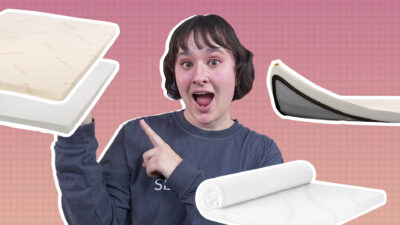Let us start by congratulating you for embarking on a quest to find the best pillow. With so many options out there, pillow-shopping can get pretty overwhelming, and it’s tempting to keep snoozing with the same ones you’ve had since high school (we’ve all been there).
Why settle for less when you can sleep with the pillow that’s perfect for you? We’re about to take you through our Best Pillows of 2024 roundup! Our team of Certified Sleep Science Coaches has hand-picked 10 that appeal to a wide variety of sleep styles, temperature preferences, and budgets so that everyone can find their perfect match.
Best Pillows of 2024
- Saatva Latex Pillow – Best Overall Pillow
- Luxome LAYR Pillow – Best Luxury Pillow
- Coop Sleep Goods Eden Pillow – Best Hypoallergenic Pillow
- Cozy Earth Silk Pillow – Best Silk Pillow
- Brooklyn Bedding Luxury Cooling Pillow – Best Cooling Memory Foam Pillow
- Layla Kapok – Best Pillow for Side Sleepers
- Brooklinen Down Pillow – Best Down Pillow
- TEMPUR-Cloud Pillow – Best Pillow for Back Sleepers
- Puffy Pillow – Best King Size Pillow
Best Pillow 2024 Video Review

Best Overall Pillow – Saatva Latex Pillow
Saatva Latex Pillow
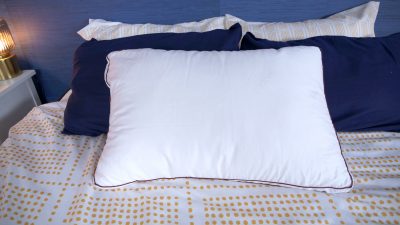
A fluffable mix of down-alternative and Talalay latex makes this pillow cozy, cool, and great for combo sleepers.
Sleepopolis Score
4.80 / 5





Read Full Review
You know those pillows that remind you of a hotel? Plush and comfortable, yet structured and supportive? Well, if you want to have that kind of sleeping experience every night at home, try out the Saatva Latex pillow, our best overall pick.
Materials
Per its name, the Saatva Latex pillow is made from a mix of down alternative and Talalay latex. We think this construction makes it extremely cozy and cool. As an added bonus, the cover is 100 percent organic cotton, and the latex core is made from renewable, natural resources. If you’re an eco-conscious shopper who likes the feel of feathers, then this pillow is a solid choice.
Why It’s a Good Pick
- Saatva’s latex pillow has a unique feel — more of a plush quality that makes it softer than other latex pillows on the market.
- The Saatva Latex pillow’s real standout feature is its shredded latex core, which offers unrivaled support.
- We really love this pillow for back sleepers. It offers the perfect amount of soft cushioning and support to keep their necks and spines aligned.
- Combination sleepers should also feel comfortable, as should stomach sleepers if they take out the insert.
Dive deeper in our full Saatva Latex pillow review.
Price: $165–$185, with a 45-night trial and one-year warranty.
Best Luxury Pillow – Luxome LAYR Pillow
Luxome LAYR Pillow
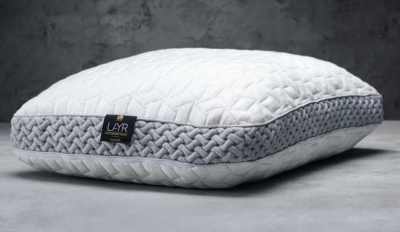
The LUXOME LAYR Pillow is a customizable option with CertiPUR-US certified memory foam and naturally cooling bamboo.
The best pillow is different depending on the person, as we have to think about multiple factors that range widely between shoppers. However, the Luxome LAYR’s customizable ability allows it to cater to most preferences, with a luxurious feel to boot. You can select the firmness and loft that’s most comfortable for your needs, regardless of your body weight or sleeping position.
Materials
The adjustability of the Luxome LAYR pillow results from three different inserts (soft, medium, and firm). By mixing and matching these inserts, you can change the overall feel and/or loft of your pillow. Each insert’s filling varies; the soft insert uses down alternative, the medium insert uses shredded foam and down alternative, and the firm insert uses memory foam blocks.
Why It’s a Good Pick
- This pillow provides a luxurious feel, thanks to its bamboo viscose cover. You should notice its soft, comfortable feel the second your head hits the pillow.
- Bamboo is a naturally cooling material, so we think hot sleepers should appreciate the moisture-wicking, breathable properties of the outer cover. For extra cooling, the memory foam used in the inserts is gel-infused.
- This pillow is ideal for those suffering from allergies, as the bamboo viscose cover is naturally hypoallergenic.
- For added convenience, each of the covers is machine-washable.
Our full Luxome LAYR pillow review is coming soon.
Price: $120–$150, with a 30-night trial.
Best Hypoallergenic Pillow – Coop Sleep Goods Eden Pillow
Coop Eden Pillow
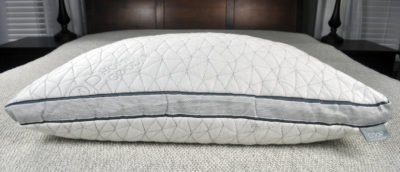
With cooling Lulltra fabric and shredded gel-infused memory foam fill, this down alternative pillow from Coop Sleep Goods is great for hot sleepers, side sleepers, and back sleepers.
Sleepopolis Score
4.60 / 5





Read Full Review
For sleepers who struggle with allergies, it can be difficult to know which materials are safe and which will irritate them. Luckily, they don’t have to worry with the Coop Sleep Goods Eden pillow. Because it’s CertiPUR-US certified and GREENGUARD Gold certified, you can rest assured that this pillow is free of harmful chemicals or potential allergens.
Materials
The Eden is a shredded memory foam pillow. The cover is made up of a proprietary blend of what Coop calls Lulltra fabric — a blend of bamboo-derived viscose rayon and polyester, which is partly what makes it hypoallergenic. The inner lining is made up of 100 percent polyester.
Why It’s a Good Hypoallergenic Choice
- The Eden pillow is CertiPUR-US certified and GREENGUARD Gold certified, meaning it’s been tested and found to produce a) low chemical emissions, and b) that it’s made without formaldehyde, heavy metals, mercury, lead, flame retardants, or ozone depletion.
- Its memory foam is gel-infused for cooling. This can assist with clearer breathing.
Could this be the perfect pillow for you? Read our full Coop Sleep Goods Eden pillow review.
Price: $96–108, with a 100-night trial period and five-year warranty.
Best Silk Pillow – Cozy Earth Silk Pillow
Cozy Earth Silk Pillow
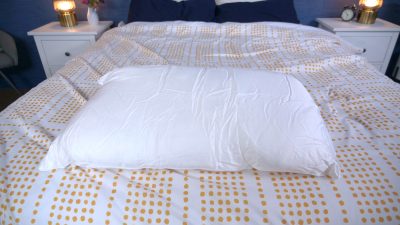
Made with 100 percent silk for the filling, this pillow will provide combination sleepers with a soft, luxurious feel.
Sleepopolis Score
4.90 / 5





Read Full Review
This durable and luxurious pillow from Cozy Earth is filled with mulberry silk, resulting in a soft feel endorsed by Oprah Winfrey herself.
Materials
Cozy Earth takes pride in its silk pillow, placing importance on its careful construction and high-quality materials. In its fill, you’ll find Mulberry silk. Its outer cover is made from naturally cooling bamboo viscose.
Why It’s a Good Silk Choice
- The bamboo viscose should keep hot sleepers cool, wicking away moisture throughout the night.
- The silk gives this pillow a luxurious feel.
- It comes in both standard and king sizes.
Read our full full Cozy Earth Silk pillow review for more information.
Price: $279–$349, with a generous 100-night trial period and 10-year warranty.
Best Cooling Memory Foam Pillow – Brooklyn Bedding Luxury Cooling Memory Foam Pillow
Brooklyn Bedding Luxury Cooling Pillow
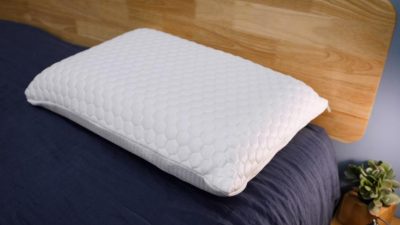
Hot sleepers that are tired of flipping the pillow looking for the cool side will love the Brooklyn Luxury Cooling Pillow!
Sleepopolis Score
4.60 / 5





Read Full Review
Even though memory foam isn’t usually known for its cooling abilities, it is possible to find a memory foam pillow that’s comfortable for hot sleepers. We’d like to point them to the Brooklyn Bedding Luxury Cooling Memory Foam pillow. Feel-wise, we find it to have some contouring while still remaining pretty buoyant — almost like a latex pillow.
Materials
The pillow starts off with a cover that’s literally cool to the touch. As for the interior, the memory foam is infused with graphite and copper. There’s also a breathable cover that’s ventilated for added airflow.
Those who have allergies could be big fans of the pillow’s materials. The construction is not only hypoallergenic, but dust mite-resistant and mold-resistant.
Why It’s Good For Hot Sleepers
- Its features are designed to keep hot sleepers cool, from the cool-to-the-touch cover to the graphite and copper infusions, which help draw heat away from the body.
- The Brooklyn Bedding Luxury Cooling Memory Foam pillow comes in king size and queen size, and is available with a high loft or low loft.
- We recommend side sleepers go with the high loft version, while back and stomach sleepers will be more comfortable with the low loft version.
Still curious? Read more in our full Brooklyn Bedding Luxury Cooling Memory Foam pillow review.
Price: $129–149, with a 30-night trial and a three-year warranty.
Best for Side Sleepers – Layla Kapok
Layla Kapok Pillow
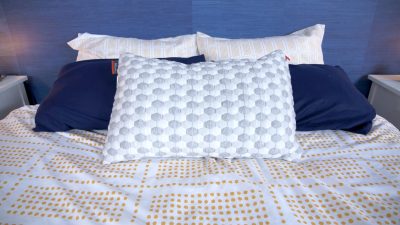
Constructed with shredded foam and natural fibers from a Kapok tree, this pillow is both plush and dense enough for side sleepers.
Sleepopolis Score
4.50 / 5





Read Full Review
Layla is a unique mattress brand known for their flippable beds. They’ve brought that same uniqueness to the Layla Kapok — an adjustable pillow that we think is perfect for side sleepers, thanks to its loft and firmness. But because you can customize the fill to your liking, we think it could also work well for other sleeping positions such as back-sleeping.
Materials
The fill of the Layla Kapok is a mixture of synthetic shredded memory foam and natural kapok fibers. These are sourced from the seeds of trees native to Mexico, Central America, the Caribbean, South America, and West Africa. The fibers are meant to be a natural alternative to down.
Encasing the fibers and foam is a cover made of 66 polyester, 30 percent viscose, and 4 percent poly lycra. All of this is woven together with copper fibers that should help cool the pillow.
Why It’s a Good Choice for Side Sleepers
- The Layla Kapok has a fairly firm feel, which is usually what side sleepers need.
- It also has a high loft that should keep side sleepers’ heads and necks supported.
- If you’re a side sleeper with narrower shoulders, you can remove the fill to lower the loft.
Get to know this product better in our full Layla Kapok pillow review.
Price: $109–$129
Best Down Pillow – Brooklinen Down Pillow
Brooklinen Down Pillow
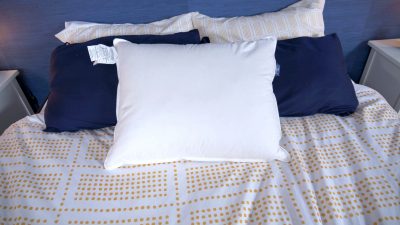
The Brooklinen Down pillow is available in three firmness levels, making it versatile for a variety of sleepers.
Sleepopolis Score
4.30 / 5





Read Full Review
Available in three different firmness levels (Plush, Mid-Plush, and Firm), the Brooklinen Down pillow has something for every sleeping position. Its down filling is soft and moldable, so it easily conforms to your head, neck, and shoulders.
Materials
The down pillow is filled with — what else? — down. Specifically, Canadian down clusters. In the Plush version, the pillow is filled with just down, while in the Mid-Plush and Firm versions, there’s also an inner core of feathers for more support. The cover is made from 100 percent cotton sateen.
A quick note on the difference between down and feathers: down is just the fluffy part of the feather, while feathers also include the spine.
Why It’s a Good Down Choice
- The three different firmness levels allow sleepers to choose their desired loft.
- Regardless of which firmness level you choose, the down creates a soft and fluffy feel.
- The sateen of the cover is luxurious and satiny.
Learn more in our full Brooklinen Down pillow review.
Price: $109–$129, with a one-year return and warranty.
Best for Back Sleepers – TEMPUR-Cloud Pillow
TEMPUR-Cloud Pillow
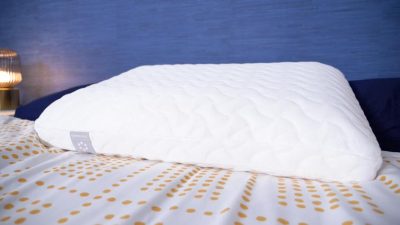
The TEMPUR-Cloud is a super adaptive memory foam pillow that can work for every sleeping position.
Sleepopolis Score
4.50 / 5





Read Full Review
If you’re a back sleeper searching for the pillow of your dreams, then the TEMPUR-Cloud pillow could be a perfect match for you. This sleep accessory was created by Tempur-Pedic, a longstanding brand in the sleep industry known for its extra-cushy TEMPUR Material.
Materials
Built with the brand’s proprietary TEMPUR Material, this pillow offers a super-slow response to pressure and should conform to your body shape. This means that memory foam lovers should really take a liking to the feel of this pillow.
Let’s take a second to talk about this pillow’s cover. It’s made from a moisture-wicking polyester material that’s so soft, you almost don’t need a pillowcase. Also, it’s washable, so those who like easy cleaning will definitely appreciate that aspect of the pillow.
Why It’s Great For Back Sleepers
- It has a medium height that’s just right when sleeping on your back.
- The height, in combination with its ultra-contouring feel, will provide back sleepers with some great support that should help prevent neck and back pain.
- With that being said, we think that this pillow should work in pretty much every sleeping position. We found that back sleepers’ spinal alignment remained proper, that the foam compresses enough to keep the neck comfy for stomach sleepers, and that it still provides good support and height for many side sleepers.
Interested in learning more? Check out our full Tempur-Pedic TEMPUR-Cloud pillow review.
Price: $89, with free shipping and a five-year warranty.
Best King Size Pillow – Puffy Pillow
Puffy Pillow
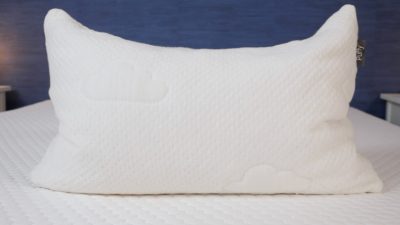
The Puffy Pillow is a great choice for sleepers looking for a pillow with customizable comfort, targeted support, and allergy-friendly properties.
Sleepopolis Score
4.90 / 5





Read Full Review
Don’t be fooled by the brand name name — this king size pillow has a slightly firm feel. But you can also adjust the filling to your liking, which means it can work for all three sleeping positions. And with plenty of room to spread out on its extra size, back sleepers, side sleepers, and stomach sleepers alike can sleep like royalty.
Materials
The filling of the Puffy pillow is 100 percent shredded polyurethane foam (poly foam for short). Sometimes, adjustable foam is cut into cubes or strips, but the fill here is purposely left nondescript so it can more easily mold to your head and neck.
The fill sits in a polypropylene lining, which is then covered by a pillowcase made of 60 percent bamboo rayon and 40 percent polyester. It’s worth noting that the cover is machine-washable.
Why It’s a Good King Size Choice
- With discounts, you can often find a king size for around or slightly under $100.
- It’s available in either white or gray.
- The materials in the Puffy pillow are hypoallergenic.
Explore this sleep accessory further in our full Puffy pillow review.
Price: $102–$120, with a 101-night sleep trial and lifetime warranty.
Methodology: How Do I Pick The Right Pillow?
Regardless of your preferred sleeping position, your pillow’s most important job is to support healthy posture by keeping your head, neck, and spine in neutral alignment.
The natural C-curve of your spine should be supported rather than craned into an unsafe position. To see if you have a neutral spine alignment, ensure your ears are in line with your shoulders and your chin is in line with your sternum.
Below, we’re going to reveal important pillow-shopping considerations so you purchase the right model for your preferred sleep position. For more details, check out our guide to picking the best pillow for your position.
- Side Sleeping: Side sleepers are most compatible with pillows offering a firmer feel and a lofty profile. A pillow with a tall loft of four inches or higher holds your head in alignment with your spine while relieving pressure at the shoulders and hips. Meanwhile, firmer support prevents your head from sinking throughout the course of the night. If you want to know more about side sleeping, check out our guide to the best pillows for side sleepers.
- Back Sleeping: When it comes to firmness levels and feel, back sleepers should stick to what we call a “happy medium” build. This means your pillow’s loft and firmness should have a medium rating to promote healthy posture. Back sleepers have a little more room to experiment with loft and firmness. Learn more in our best pillows for back sleepers roundup.
- Stomach Sleeping: Unlike back sleepers, stomach sleepers should stick to a hard and fast rule for proper spinal alignment. If you’re a stomach sleeper, a soft pillow with a low loft will support the natural curvature of your spine, and prevent your head/neck from craning upwards. Because it can be easy to strain your neck in this position, finding a stomach sleeper pillow can be kind of tricky. For a range of options, check out our best pillows for stomach sleepers.
- Combination Sleeping: If you tend to switch positions throughout the night, you’ll want a pillow that’s versatile enough to be comfortable in most positions. You’ll also want to opt for a larger pillow, since combo sleepers tend to slip off their pillows throughout the night. We’d recommend a medium-loft pillow for most combo sleepers, which should help keep your spine in a neutral position. Check out our best pillow for combination sleepers roundup for more information.
Once you’ve found the pillow that supports healthy sleeping posture, you’re ready to dive into the exciting details! For example, take some time to decide if you want a pillow that feels silky or fuzzy. Warming or cooling. Traditionally shaped or ergonomic. The world of pillows is vast, and it’s worth it to find one that’s just right.
What Types of Pillows Are There?
These days you can find pillows made with a range of materials and pillow fills. Whether you love the traditional feeling of soft down, or want an ergonomic memory foam pillow, you’ll be able to find a new pillow that suits your sleep needs.
- Down Pillows: These pillows have a fill made from quill-less duck and goose feathers. These feathers come from the chest or underbelly of the bird and are known to be the softest. Down pillows have a cloud-like feel and are softer and more expensive pillows.
- Down Alternative Pillows: If you love the feel of down, but want a hypoallergenic (and cheaper) option, then down alternative pillows might be right up your alley. These pillows are typically made from a fill of polyester microfibers. They are designed to mimic a down feel at less of a cost.
- Memory Foam Pillows: As a pillow fill, memory foam is a newer material designed to cradle your body. It has a slow response to pressure and is denser than down or down alternative. Memory foam pillows are more ergonomic than other pillows, and are a great choice for those who suffer from neck pain.
- Memory Foam Alternative Pillows: These days, lots of brands have their own proprietary memory foam versions that feel like the classic material with a few tweaks. For example, memory foam does have a reputation for trapping body heat, but memory foam alternative pillows can be filled with cooling materials. Gel memory foam pillows are common, but you can find memory foam pillows with graphite or copper infusions, which help dissipate heat. Memory foam alternative might be more aerated, which helps improve breathability.
- Latex Pillows: These pillows are filled with natural Talalay or Dunlop latex, sourced from rubber trees. Latex has a bouncy, buoyant feel and is almost like the opposite of memory foam. It provides some nice pressure relief, and is known to be naturally cooling. Latex pillows tend to be on the pricier side.
- Hybrid Pillows: These are a new type of pillow on the market. They’re reversible and adjustable pillows with a soft, down-like side and a firmer side that tends to have cooling properties. These are great for sleepers who aren’t sure what they want or like to switch things up. The Leesa Hybrid pillow is one of the few we’ve tested.
What Does Pillow Loft Mean?
If you’ve never heard of pillow loft before, don’t worry. It simply refers to the pillow’s height. Depending on your sleeping style, you’ll want to opt for a certain pillow loft.
- Low-Loft: Low-loft pillows tend to be three inches tall or less. These pillows are best for stomach sleepers, who need little to no loft to achieve a neutral spinal alignment.
- Mid-Loft: Mid-loft pillows are three inches to five inches tall. They’re best for back or combination sleepers, since they provide a medium amount of support.
- High-Loft: These pillows are five inches or taller and are best for strict side sleepers. Side sleepers need a higher loft to keep their neck positioned in line with their spine, which helps prevent neck pain.
What Size Pillows Can I Buy?
Many brands offer pillows in more than one size. The typical sizes you’ll find are standard, queen, and king. You can also find specialized pillows like body pillows and ergonomic pillows.
- Standard: Standard size pillows measure 20 inches by 26 inches. Standard pillows are the least expensive pillow size and are the most commonly used.
- Queen: Queen pillows measure 20 inches by 30 inches. Two of these pillows fit nicely on a queen size bed. Hotel pillows are often queen size.
- King: King size pillows are the largest at 20 inches by 36 inches. They are great for sleepers who tend to move around a lot, since they offer quite a lot of surface area. These pillows are the most expensive of the bunch.
- Body: Body pillows tend to measure about 20 inches by 54 inches. These pillows are particularly useful for side sleepers, who can place them between their legs to prevent knee rubbing.
Caring for Your Pillow
How Often to Clean
We recommend cleaning pillowcases every week or two, while the entire pillow should be washed two to four times a year.
How to Clean
Above all else, we recommend reading the manufacturer’s instructions on how to properly care for your pillow. When in doubt, wash your pillow with cold water and mild detergent. Ensure you thoroughly air-dry your pillow to rid excess moisture.
Most memory foam pillows should not be washed in a machine. We recommend spot-cleaning these pillows and airing out completely, or using a vacuum hose to remove any loose particles.
Removable covers can be a fantastic way to make pillow care convenient, so we definitely recommend investing in them.
Final Thoughts
You’ve seen our favorite pillows, and you’re ready to get shopping. Before you do, remember to keep a close eye on loft, firmness, and all the little details that cater to your unique sleep needs. And take advantage of those trial periods when they’re offered! After all, personally testing a pillow can be a great way to make sure that it will support you all night long. Happy shopping, everybody!
FAQs
What are the most comfortable pillows to sleep on?
It’s going to depend on your sleeping position. See above for our breakdown of what type of pillow might appeal to back sleepers, side sleepers, stomach sleepers, and combination sleepers. You should also consider what kind of feel you’re looking for — soft, firm, responsive, etc. From there, you can make an educated decision.
What is the best pillow for neck pain?
The best pillow for neck pain is the one that promotes neutral spine alignment when you’re in your go-to sleeping position. Of course, this looks different for each position, but making sure that your head and neck are never craned out of alignment with your spine is the best way to alleviate neck pain.
How long should you keep pillows?
In general, you should replace your pillow every one to two years. However, the lifespan of your pillow largely depends on the materials used to make it! I suggest checking in with your pillows every six months to make sure they’re still supporting you properly.
What pillow filling is best?
Different fillings are going to result in different feels. For example, down pillows tend to be extremely soft. Memory foam pillows give you a good deal of contouring. Latex pillows are usually responsive and cooling. It’s all about identifying your personal preferences, then making an informed purchase.
How much should you pay for a good pillow?
There are lots of different high-quality pillows out there with lots of different prices. To give you some perspective, most of the pillows in this roundup are between $75 and $179. This is a fairly accurate range for a pillow that should keep you comfortable, promote healthy sleep posture, and last you a long while.
FAQs
What are the most comfortable pillows to sleep on?
It's going to depend on your sleeping position. See above for our breakdown of what type of pillow might appeal to back sleepers, side sleepers, stomach sleepers, and combination sleepers. You should also consider what kind of feel you're looking for — soft, firm, responsive, etc. From there, you can make an educated decision.
What is the best pillow for neck pain?
The best pillow for neck pain is the one that promotes neutral spine alignment when you’re in your go-to sleeping position. Of course, this looks different for each position, but making sure that your head and neck are never craned out of alignment with your spine is the best way to alleviate neck pain.
How long should you keep pillows?
In general, you should replace your pillow every one to two years. However, the lifespan of your pillow largely depends on the materials used to make it! I suggest checking in with your pillows every six months to make sure they’re still supporting you properly.
What pillow filling is best?
Different fillings are going to result in different feels. For example, down pillows tend to be extremely soft. Memory foam pillows give you a good deal of contouring. Latex pillows are usually responsive and cooling. It's all about identifying your personal preferences, then making an informed purchase.
How much should you pay for a good pillow?
There are lots of different high-quality pillows out there with lots of different prices. To give you some perspective, the pillows in this roundup are between $75 to $179. This is a fairly accurate range for a pillow that should keep you comfortable, promote healthy sleep posture, and last you a long while.

Amelia Jerden
Senior Staff Writer
About Author
Amelia is a Senior Staff Writer for Sleepopolis. She primarily covers bedding and sleep accessory products in reviews, how-to guides, and more. You can also find her over on the Sleepopolis YouTube channel. Amelia is a graduate of the University of North Carolina at Chapel Hill, with double majors in media and journalism and in dramatic art. Outside of work, Amelia can usually be found on a hike, traveling to a new city, or at her local thrift store.
Back Sleeper


